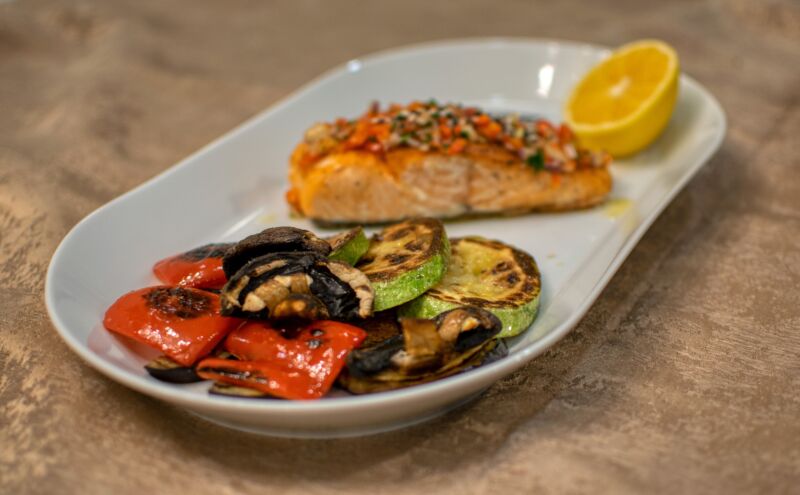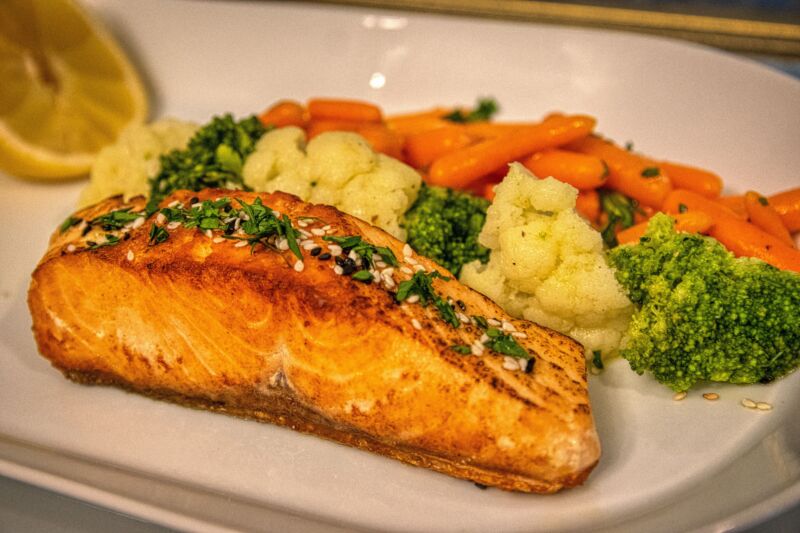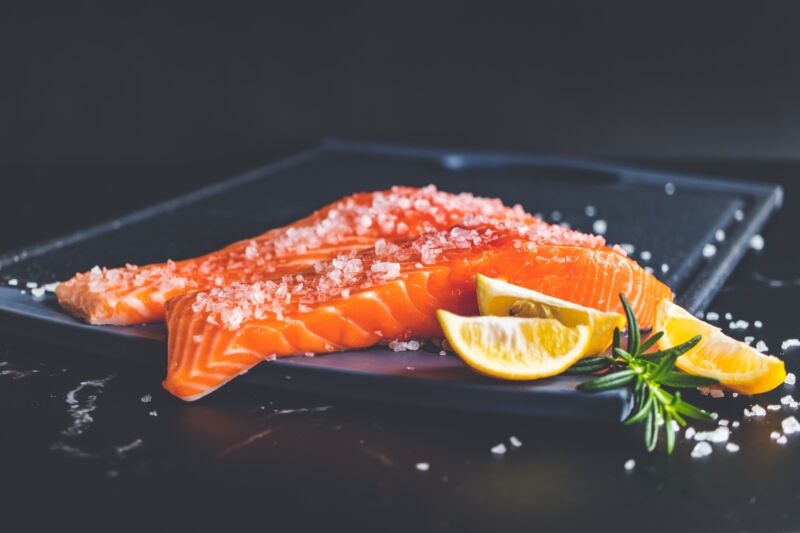How to Cook Salmon in the Oven?
Salmon is one of the most delicious and versatile fish to cook. Not only is salmon healthy, full of protein and omega-3 fatty acids, it also has a tender texture and rich flavour that pairs well with a variety of seasonings and cooking methods.
One of the easiest ways to cook salmon is in the oven. Oven-baked salmon is a fuss-free way to achieve moist, flaky and perfectly cooked fish right at home. With minimal preparation needed, baked salmon fillets make for an easy weeknight dinner or elegant entree for entertaining guests.
Follow this simple guide to learn all about how to cook salmon in the oven, from choosing the right temperature and cook times to seasoning and serving suggestions. With these helpful tips, you’ll be able to master baking salmon in no time!
What’s the Best Temperature to Cook Salmon?
When it comes to finding the ideal oven temperature for cooking salmon, there is no definitive right answer. The best baking temperature depends on your desired texture and cooking time. Here are some common oven temperatures for salmon and their effects:
425°F (215°C)
- Crispy skin – Baking at a high temperature helps render the fat under the skin, leading to super crispy and crunchy salmon skin.
- Quick cooking time – At 425°F, salmon fillets take only 4-6 minutes per half-inch thickness to cook through.
- Risk of overcooking – High heat may dry out or toughen the flesh if baked too long. Watch closely to avoid overcooking.
350°F (175°C)
- Gentler approach – The moderately low temperature gently bakes the salmon without aggressive high heat.
- Cooking time of 20-25 minutes – Expect a cooking time of around 25 minutes for a 1-inch thick fillet.
- Moist and tender – The fish remains moist and tender at the lower temperature.
400°F (205°C)
- Commonly recommended – 400°F is a popular temperature for baking salmon.
- Even cooking – Salmon bakes evenly throughout without drying out.
- 15-20 minute cook time – Fillets take 15-20 minutes to cook at 1-inch thickness.
No matter what temperature you choose, it’s critical to use a meat thermometer to check the internal temperature, ensuring the salmon reaches 145°F (63°C) before serving. This guarantees it’s cooked through for food safety.
How Long Does It Take To Cook Salmon In the Oven?
The oven baking time for salmon largely depends on two factors:
Size and Thickness of the Fillets
- Thicker cuts take longer to cook through to the center. Aim for around 12-15 minutes for average store-bought fillets that are about 1-inch thick in the thickest part.
- If you are baking salmon steaks or extra wide fillets, extend the bake time as needed until the center flakes apart and registers 145°F (63°C) on a meat thermometer.
Desired Level of Doneness
- For salmon that’s rare in the middle, bake for a shorter time than well-done salmon.
- If you prefer your salmon fully cooked through, bake at the higher end of the time range.
Here are some general salmon cooking time guidelines based on oven temperature:
350°F (175°C)
- Bake for around 25 minutes per 1-inch thickness.
- The thickest part of the fillet should flake apart easily when poked with a fork.
400°F (205°C)
- Cook for approximately 15 minutes for a 1-inch thick salmon fillet.
- The innermost center should register 135°F (57°C) on a meat thermometer when done.
425°F (215°C)
- Aim for 4-6 minutes per 1/2-inch thickness as a general rule.
- Most store-bought fillets are about 1-inch thick at the thickest point.
- Fully cooked salmon fillets will take 12-15 minutes at this high temperature.
- Check the inner temperature to confirm doneness.
For food safety, bake the salmon until it reaches 145°F (63°C) internally before removing it from the oven. Use an instant-read thermometer to accurately determine doneness.
Foil or Parchment Paper?

When baking salmon in the oven, you can cook it directly on a foil-lined baking sheet, wrap it in a foil packet or use parchment paper:
Benefits of Foil
- Wrapping salmon in a sealed foil packet traps in moisture and flavor.
- Foil conducts heat well for even cooking.
Downsides of Foil
- Salmon can stick to the foil, making it hard to remove.
- Foil may rip and tear when opening the packet.
- There are health concerns about aluminum leaching into food.
Benefits of Parchment Paper
- Parchment allows air flow for excellent browning without risk of sticking.
- No need to oil the paper and easy cleanup by tossing it out after cooking.
Downsides of Parchment
- Less effective at sealing in moisture compared to foil packets.
- Salmon may cook up slightly drier.
Ultimately, the choice comes down to personal preference and the particular recipe. Foil is ideal when moisture retention is a priority, while parchment works well for easy oven-roasting at high heat.
What to Serve With Salmon
Salmon goes well with a variety of side dishes that complement its flavor without overpowering it. Here are some tasty options:
Roasted Vegetables
- Asparagus, Brussels sprouts, carrots and broccoli all pair nicely with salmon. Roast them in the oven while the fish bakes.
Rice
- Steamed white or brown rice are classic partners for salmon. Or try flavored rice like lemon-butter or garlic Parmesan.
Quinoa
- Quinoa provides a protein boost to balance salmon’s richness. Toss in fresh herbs and lemon juice for extra flavor.
Salad
- A light salad with spinach, mixed greens or arugula is a refreshing salad pairing for salmon. Top with fresh veggies and a citrus vinaigrette.
Potatoes
- Roasted, mashed or boiled potatoes go well with baked salmon. Potatoes provide starchy comfort to complement the fish.
How to Season Baked Salmon?
One of the great things about salmon is how versatile it is when it comes to seasoning and flavor combinations.
You can keep it simple with just salt and pepper. Or punch up the flavor with bold spices and herbs like garlic, mustard, chili powder, paprika and fresh parsley or dill.
Salmon also shines with citrus – try lemon herb, orange ginger or lime cilantro seasonings. It’s equally delicious with savory umami flavors like soy sauce, sesame oil and Hoisin.
Here are some easy and popular ways to season baked salmon fillets:
- Lemon, garlic, oregano and butter
- Cajun seasoning or blackening seasoning
- Pesto sauce or tapenade
- Honey mustard glaze
- Teriyaki or soy sauce marinade
- Balsamic, herbs and garlic
- Mediterranean spices like fennel, coriander and cumin
The key is to complement, not overwhelm, the natural rich flavor of the salmon. Aim for a simple blend of flavors that isn’t too complicated or intensely spiced.
FAQs About Cooked Salmon
Still have questions about how to bake salmon to juicy perfection? Here are answers to some common queries:
How Long to Cook Salmon at 425°F?
At 425°F (218°C), allow about 4-6 minutes per 1/2-inch thickness. A 1-inch thick fillet will typically take 12-15 minutes to bake until just cooked through and flakes easily with a fork.
Should I Cook Salmon at 350°F or 450°F?
350°F (175°C) is gentler, resulting in a moist interior. Bake time is around 25 minutes.
450°F (230°C) cooks the salmon faster at 12-15 minutes per inch of thickness. It also crisps the skin nicely.
Is It Better to Bake Salmon at 375°F or 400°F?
375°F (190°C) takes longer than 400°F (205°C).
The higher 400°F temperature leads to a nicely browned exterior and slightly firmer, less moist texture.
Do You Flip Salmon When Cooking in the Oven?
Flipping is not necessary if the salmon has skin on one side. The skin protects the flesh from drying out and gets super crispy in the oven.
Do You Bake Salmon Covered or Uncovered?
It’s best to bake salmon uncovered at a high oven temperature like 400-425°F (205-218°C). This allows moisture to escape and the exterior to brown while keeping the interior moist and tender.
Conclusion
Learning how to cook delicious salmon in the oven is easy and worthwhile! With minimal fuss, you can enjoy foolproof baked salmon fillets packed with flavor, nutrition and gourmet appeal.
Follow this guide for prepping and baking salmon to buttery, flaky perfection. Vary the temperature, seasoning and accompaniments to suit your tastes. Soon this impressive yet easy fish dish will become a regular staple in your kitchen routine!

